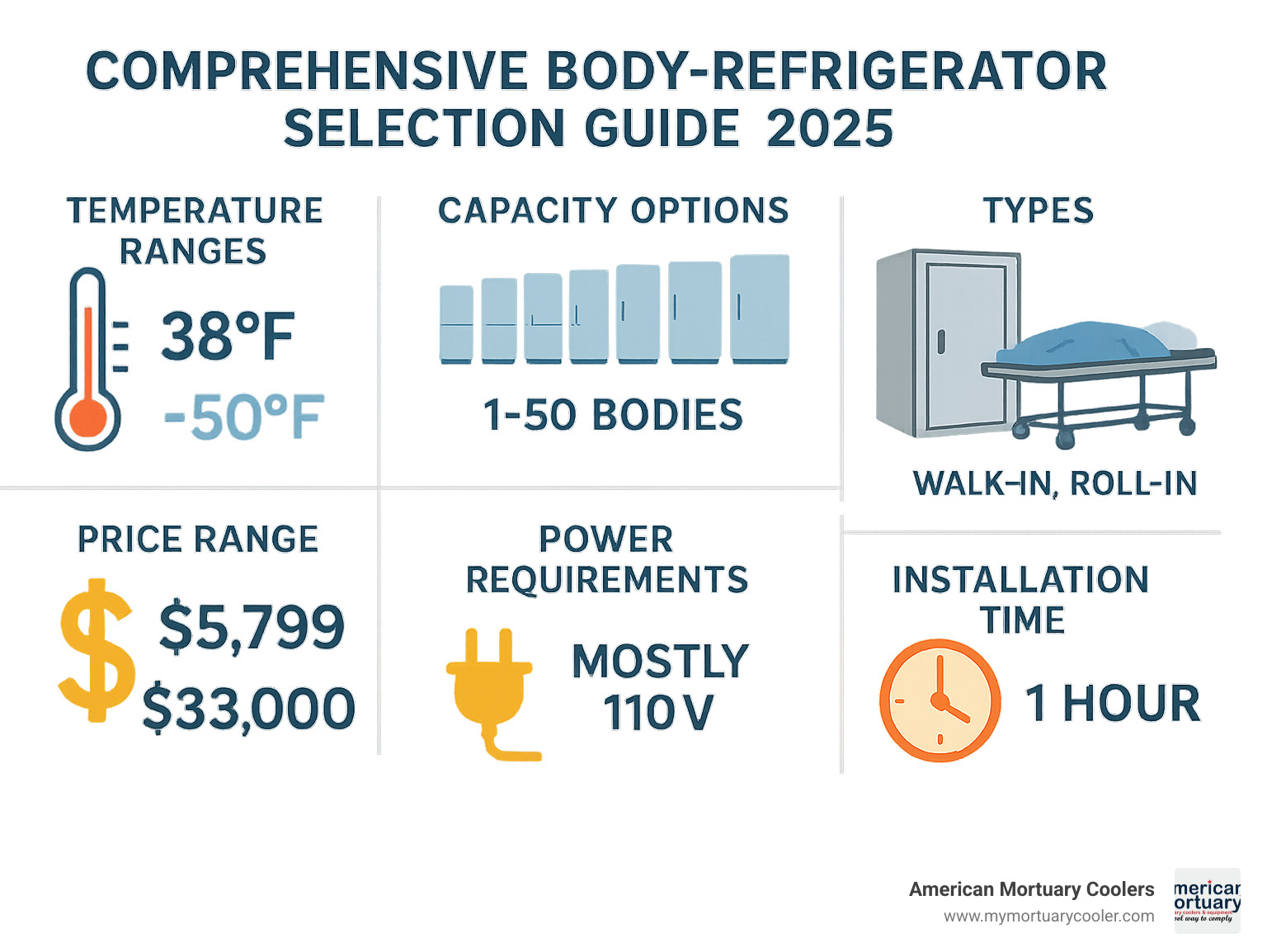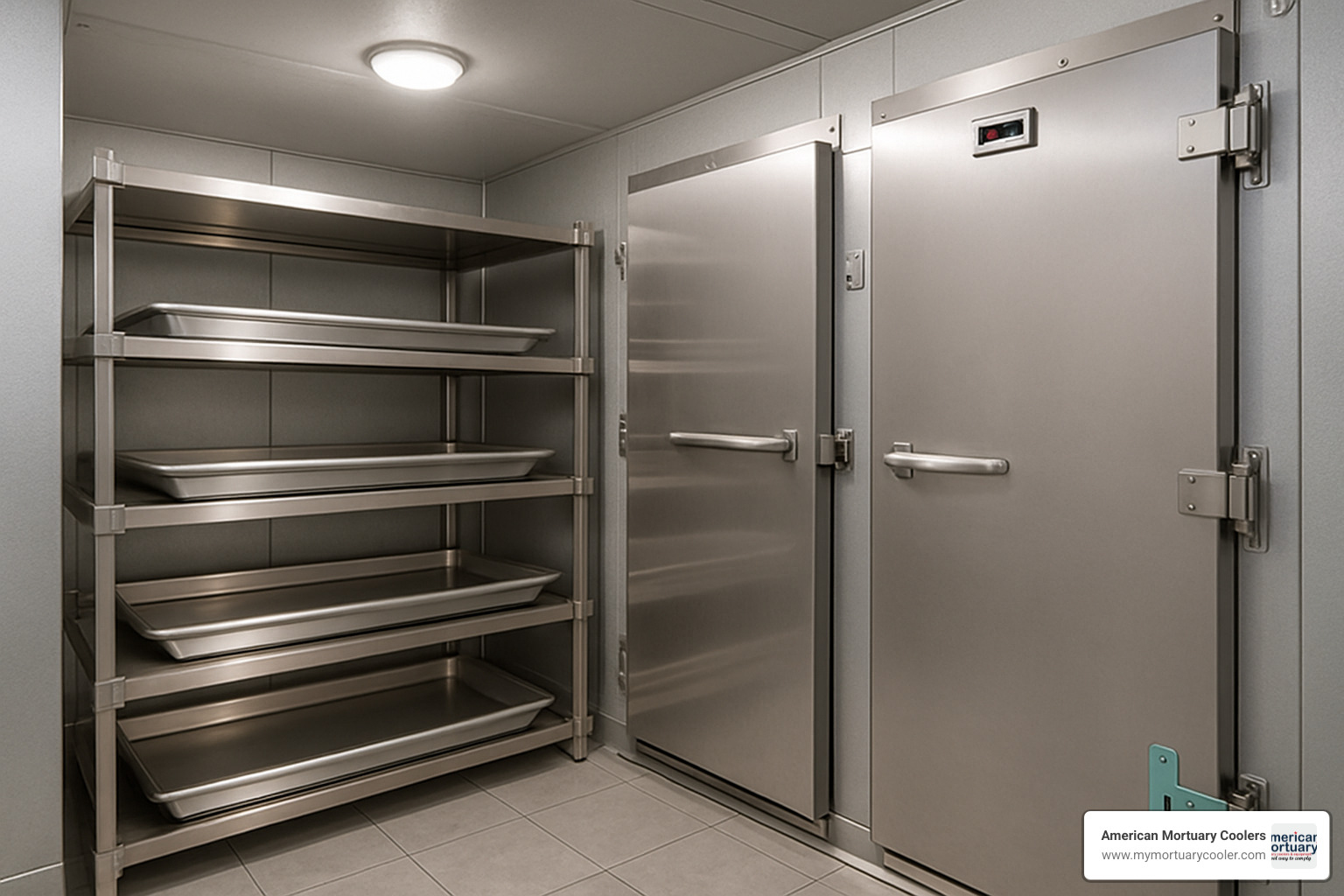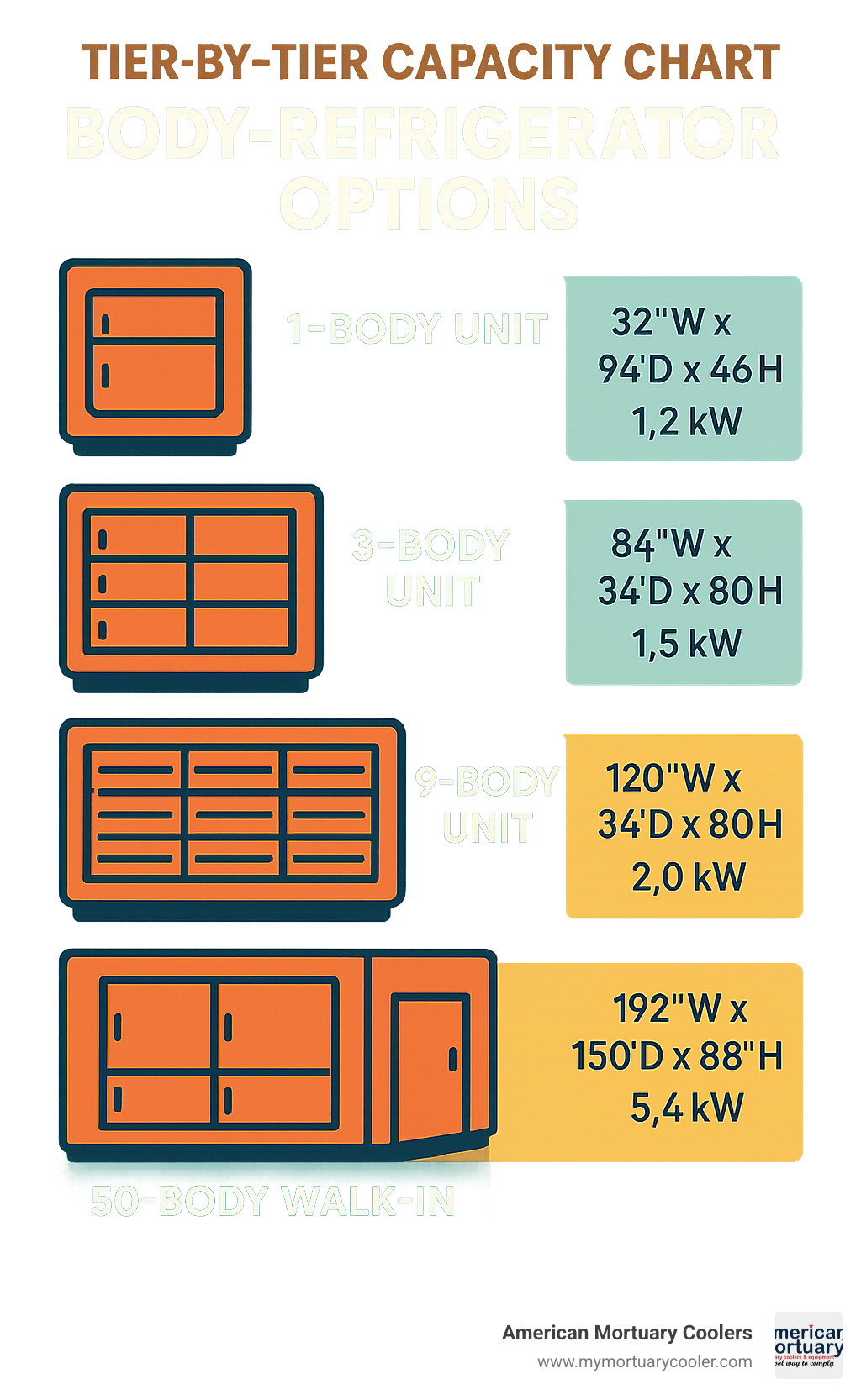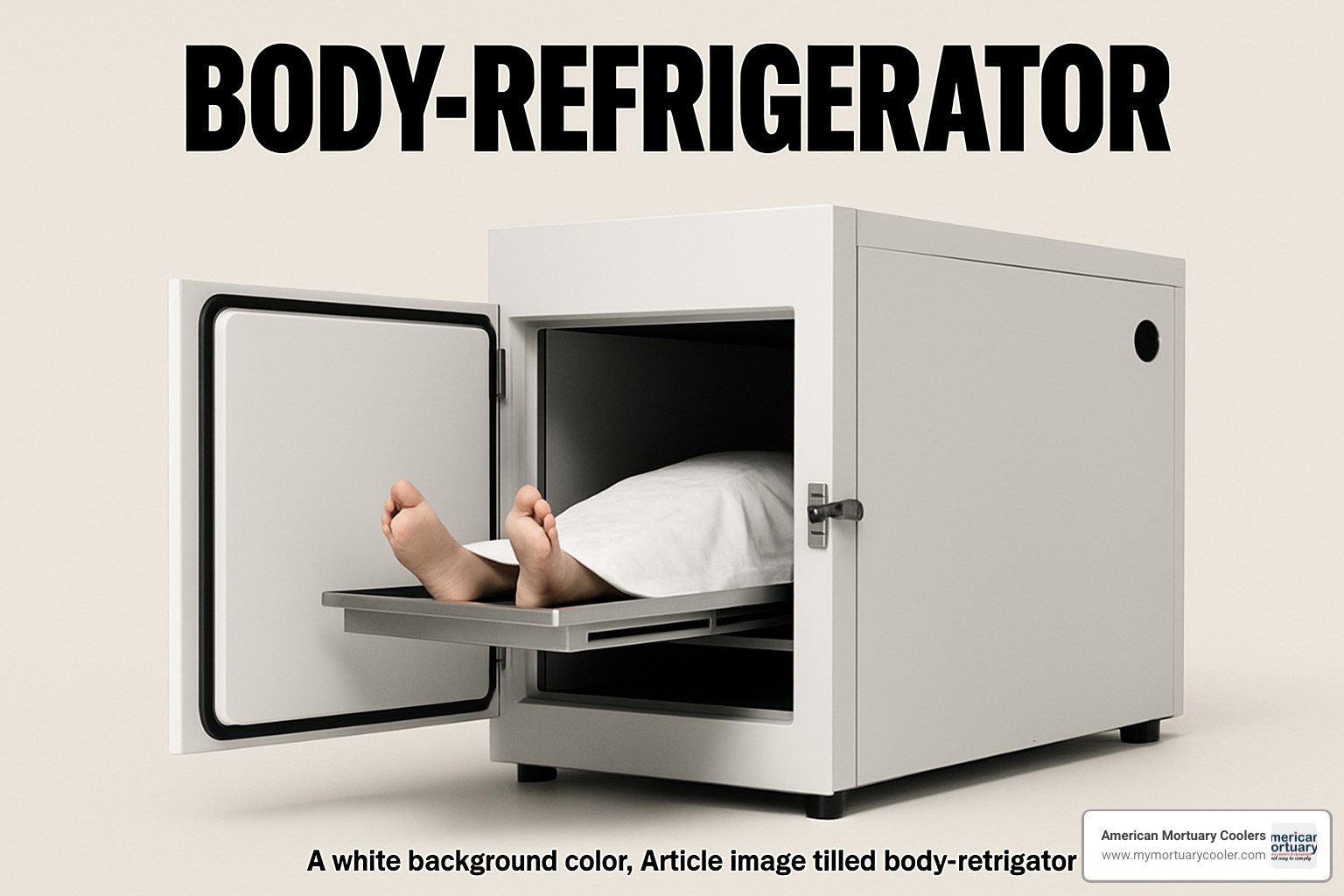Why Proper Body-Refrigerator Selection Matters for Your Facility
Body-refrigerator units serve as the cornerstone of mortuary operations, providing temperature-controlled storage that slows decomposition and preserves human remains with dignity. These specialized cooling systems maintain precise temperatures around 38°F (3.3°C) to give families the time they need for funeral arrangements while ensuring compliance with health and safety regulations.
Quick Answer for Body-Refrigerator Buyers:
- Temperature Range: 38°F (3.3°C) for coolers, -10°F to -50°F for freezers
- Capacity Options: 1-body units to 50-body walk-in systems
- Key Types: Walk-in, upright, roll-in, body box, and bariatric models
- Price Range: $5,799 to $33,000+ depending on size and features
- Power Requirements: Most plug into standard 110V outlets
- Installation Time: Typically 1 hour for smaller units
The mortuary refrigeration industry has evolved significantly, with modern units featuring 4-inch thick urethane insulation, stainless steel construction, and digital temperature controllers. Whether you're operating a small funeral home needing a 2-body roll-in cooler or a large facility requiring a walk-in system with cantilever racks, the right body-refrigerator becomes essential for maintaining operational efficiency and regulatory compliance.
As funeral home directors face increasing pressure to balance quality care with budget constraints, understanding the technical specifications, capacity options, and customization features of different body-refrigerator systems helps ensure you make the best investment for your facility's unique needs.
At American Mortuary Coolers, we've helped funeral facilities across all 50 states select the right body-refrigerator solutions for their operations. Based in Tennessee, we specialize in crafting custom mortuary coolers with direct delivery across the contiguous 48 states, bringing decades of experience to help you steer the technical specifications and regulatory requirements.

What Is a Body Refrigerator and Why Every Facility Needs One
A body-refrigerator is essentially a specialized cooling system that keeps human remains at carefully controlled temperatures, giving families the precious time they need to say goodbye with dignity. Think of it as the heart of any mortuary operation - without proper refrigeration, funeral directors would be under tremendous pressure to rush services, and families wouldn't have the flexibility to plan meaningful ceremonies.
The science behind these units is straightforward. When someone passes away, natural decomposition begins almost immediately at room temperature. But drop that temperature down to the industry standard of 38°F (3.3°C), and you've bought yourself valuable time - sometimes weeks instead of hours.
This preservation window isn't just about logistics. It's about giving families space to grieve, gather relatives from out of town, and create the kind of farewell their loved one deserves. Every funeral director knows that rushed arrangements rarely feel right to grieving families.
Primary Purpose & Temperature Science
Modern body-refrigerator systems use digital controllers that maintain temperatures within just a few degrees of the target setting. This precision matters more than you might think - even small temperature swings can affect how well remains are preserved.
At room temperature around 70°F, noticeable changes begin within just a few hours. But at that magic 38°F mark, the process slows dramatically. We're talking about extending preservation from hours to potentially weeks, depending on individual circumstances.
The rigor mortis process typically starts within a few hours after death and can last anywhere from 12 to 48 hours. During this natural transition, proper refrigeration helps manage these changes while maintaining the respectful environment families expect when they come to pay their respects.
Mortuary Cooler vs. Mortuary Freezer
Not all body-refrigerator systems are created equal, and understanding the difference between positive and negative temperature storage can save you from making an expensive mistake.
Positive temperature coolers operate between 2°C to 4°C (that's roughly 36°F to 39°F). These are your workhorses for standard mortuary storage, handling everything from overnight stays to several weeks of preservation.
Negative temperature freezers are a different animal entirely. Running at -10°C to -50°F (-14°F to -58°F), these units essentially hit the pause button on decomposition. They're primarily used for long-term evidence storage in forensic facilities or unusual situations requiring extended preservation.
For most funeral homes, the standard body-refrigerator operating at 38°F hits the sweet spot between effective preservation and practical operation. The latest research on corpse refrigeration backs up what morticians have known for decades - this temperature range just works.
Regulatory & Safety Framework
OSHA regulations exist for good reason. Every body-refrigerator must include safety release handles that allow doors to be opened from the inside. It's a simple feature that could save a life if someone accidentally gets trapped inside.
The regulatory framework goes beyond just safety handles. NSF certification ensures that door and panel components meet food-grade sanitation standards. EISA panels must meet specific insulation standards, which helps keep your electric bills reasonable while maintaining consistent temperatures.
Vapor-proof lighting prevents moisture buildup that could create electrical hazards or compromise the sterile environment you've worked hard to maintain. Modern alarm systems act like a watchful assistant, alerting staff to temperature problems, power failures, or doors left ajar.
The scientific research on ventilation emphasizes proper air circulation, especially in preparation rooms where staff spend hours working. After all, taking care of families means taking care of the people who serve them.
Types and Capacities of Body-Refrigerator Units

Choosing the right body-refrigerator feels a bit like finding the perfect pair of shoes— you need something that fits your space, handles your daily workload, and won't leave you scrambling during busy periods. The good news is that modern mortuary cooling systems come in sizes ranging from compact single-body units all the way up to impressive walk-in systems that can store 50 bodies.
When we talk with funeral directors about capacity planning, we always emphasize looking beyond just your average daily needs. You might typically handle two or three cases at a time, but what happens during flu season? Or when that unexpected tragedy hits your community? Smart planning means considering those peak demand periods that can catch you off guard.
The body-refrigerator industry has evolved to meet these varied needs. Whether you're running a small family funeral home or managing a large medical examiner's office, there's likely a solution that fits both your space and your budget.

Walk-In & High-Capacity (4-50 bodies)
Walk-in body-refrigerator systems are the workhorses of high-volume facilities. Think of them as custom-built rooms that happen to be very, very cold. These systems use modular panels with thick 4-inch urethane insulation that keeps temperatures steady while keeping your energy bills reasonable.
The beauty of modular construction is its flexibility. Need to expand next year? No problem—just add more panels. Moving to a new location? These systems can be taken apart, moved, and reassembled without losing their effectiveness.
Cantilever racks are where these systems really shine. These adjustable storage systems let you stack bodies on multiple tiers while still providing easy access for your staff. The telescopic aluminum racks roll smoothly on nylon bearings, supporting trays up to three-quarters of their length. No more wrestling with heavy loads or struggling to reach cases stored in awkward positions.
Many facilities opt for remote condensers, which move the noisy compressor equipment outside the building. Your staff will appreciate the quieter work environment, and you'll get better temperature control since the condenser isn't fighting against indoor humidity and heat.
For facilities handling 4 to 50 bodies, these walk-in systems offer the best combination of space efficiency and operational flexibility. Our practical guide to choosing a walk-in body refrigerator covers the sizing and configuration details that help ensure you get exactly what you need.
Upright, Roll-In & Body Boxes (1-15 bodies)
Smaller body-refrigerator units are all about convenience and quick installation. Most of these units plug into a standard 110V outlet—the same type you'd use for a large appliance at home. They typically ship "knocked down" to prevent damage during transport, but assembly takes about an hour with basic tools.
Side-loading units work great in tight spaces where you can't swing a full door open, while front-loading models offer the traditional access most staff prefer. Roll-in models are particularly popular because they accommodate standard mortuary cots and gurneys directly. No lifting, no transferring—just roll the cot right into the cooler.
Caster-mounted units give you the flexibility to move equipment when you're rearranging your facility or need to accommodate special situations. The wheels lock securely during operation, so you get mobility without sacrificing stability.
Our 2-body roll-in cooler (Model #2BR) has become our most popular unit for good reason. With external dimensions of 7'3" x 3'3/4" x 5'2", it fits into most preparation rooms while providing reliable storage for two standard cases. The 1/3 HP compressor delivers 2610 BTUH of cooling capacity—more than enough to maintain proper temperatures even during frequent door openings.
These smaller units work perfectly for funeral homes handling 1 to 15 bodies at capacity. Our complete guide to choosing a body storage refrigerator provides detailed specifications to help you compare options.
Bariatric & Mobile Body-Refrigerator Solutions
Bariatric body-refrigerator units address a growing need in our industry with dignity and practicality. These specialized units feature extra-wide doors and 34-inch trays compared to the standard 27-inch width. The reinforced construction handles the additional weight while maintaining the same temperature control and reliability you expect.
Lift compatibility becomes crucial with bariatric units. Manual handling isn't just difficult—it's potentially dangerous for your staff and disrespectful to families. These systems integrate seamlessly with hydraulic lifts and specialized transfer equipment.
Mobile trailer units serve as your insurance policy against the unexpected. Equipment failures happen, capacity overloads occur, and disasters strike without warning. These self-contained units can be delivered and connected to standard electrical service quickly, providing immediate relief when you need it most.
Pass-through doors represent another smart customization option, allowing units to serve multiple rooms efficiently. This feature works particularly well in facilities where preparation and viewing areas are separated but share storage needs.
Key Features, Specs, and Customization Checklist

When you're investing in a body-refrigerator, you want to make sure you're getting the features that will serve your facility well for years to come. The difference between a good unit and a great one often comes down to the details that matter most in daily operation.
The heart of any quality body-refrigerator is its ability to maintain that crucial 38°F temperature consistently. Digital temperature controllers keep things steady within just a few degrees, which means you won't wake up to unpleasant surprises. The 4-inch thick urethane insulation acts like a thermal blanket, providing an impressive R-value of 8.49 per inch. This isn't just technical jargon—it translates to lower electric bills and more reliable performance, even when your facility gets warm.
Type 304 stainless steel construction with a No. 4 finish might sound fancy, but it's really about practicality. This material stands up to daily cleaning, resists corrosion, and maintains that professional appearance that families expect. Both interior and exterior surfaces use this grade of stainless steel, so you're not getting a unit that looks good on the outside but cuts corners where it counts.
Door orientation matters more than most people realize. Whether you need pass-through doors for workflow efficiency or specific swing directions for tight spaces, these choices affect how smoothly your facility operates day after day.
Choosing the Right Body-Refrigerator for Your Workflow
Your facility's footprint determines more than just where the unit fits. You need space for doors to open fully, room for staff to maneuver gurneys safely, and access for service technicians. A roll-in unit needs extra maneuvering space, while an upright model might need overhead clearance for loading.
Rack style selection impacts both how many bodies you can store and how easily staff can access them. Telescopic end-load racks pack in maximum capacity but need deeper spaces to operate smoothly. Side-load configurations work beautifully in narrow prep rooms but may limit your total capacity. Roller rack systems provide the smoothest operation—your staff will appreciate this during busy periods.
Power requirements can make or break your installation timeline. Most body boxes and smaller upright units plug into standard 110V outlets, making installation straightforward. Larger units often need 208-230V service, which might require electrical upgrades. Knowing your facility's electrical capacity upfront saves headaches later.
Environmental controls become essential when you're running multiple units or dealing with challenging conditions. Redundant refrigeration systems provide peace of mind with backup cooling, while humidity control prevents condensation issues that can compromise both sanitation and equipment life.
For deeper insights into temperature management strategies, our complete guide to morgue cooler temperatures covers everything you need to know.
Optional Upgrades & Smart Monitoring
Modern body-refrigerator systems offer smart features that transform routine maintenance from reactive to proactive. Digital data loggers automatically record temperature, humidity, and door activity, creating the compliance documentation that inspectors love to see.
Cloud-based monitoring lets you check system status from anywhere, whether you're at home or traveling. The mobile apps send alerts for temperature deviations or power failures, so you can address issues before they become expensive problems.
UPS backup systems keep your body-refrigerator running during brief power outages. These battery backup systems can provide several hours of operation, depending on your unit size and how warm it gets in your facility. It's like insurance for your most critical equipment.
UV-C sanitation systems add an extra layer of infection control by sterilizing the air circulation within your unit. This upgrade is particularly valuable if you handle infectious cases or simply want to maintain the highest sanitation standards for your families.
Installation, Maintenance, and Cost Planning
Getting your body-refrigerator up and running properly starts with understanding the basics of site preparation and installation requirements. Most units are designed with simplicity in mind, but there are still some important considerations that can make or break your investment.
Ambient temperature limits are probably the most overlooked factor in installation planning. Most standard compressors work reliably up to 95°F ambient temperature, but push beyond that and you're asking for trouble. If your facility gets particularly hot during summer months, you might need to invest in upgraded compressors or improve ventilation around the unit.
The knock-down versus pre-assembled decision comes down to balancing cost against convenience. Knock-down shipping can save you hundreds of dollars in freight costs and reduces the chance of damage during transport. The trade-off is that you'll need to spend about an hour assembling the unit on-site. Pre-assembled units arrive ready to plug in, but you'll pay more for shipping.
Energy efficiency might not seem exciting, but it directly impacts your bottom line for years to come. Units with thicker insulation and better construction cost more initially, but the energy savings add up quickly.
Plug-and-Play 110V Set-Up Steps
Most smaller body-refrigerator units are designed for straightforward installation without needing to call in specialized contractors. The typical assembly process takes about an hour and requires basic tools you probably already have: a cam-lock wrench, power drill, socket wrench, level, rubber mallet, and tape measure.
Condenser placement deserves careful thought because it affects both performance and your daily work environment. Outdoor condensers run quieter and dissipate heat more effectively, but they need weather protection and may be harder to service. Indoor condensers are convenient for maintenance but can add heat and noise to your workspace.
Proper leveling is absolutely critical for smooth operation and door alignment. Take your time with this step using a good 6-foot level. Panels that aren't properly aligned will cause ongoing headaches with door sealing and temperature control.
For detailed installation guidance, our step-by-step guide to choosing a body fridge for storage walks you through the entire process with helpful tips we've learned from installing units across the country.
Routine Cleaning & Compliance Logs
Keeping your body-refrigerator clean and well-maintained isn't just about hygiene - it's about protecting your investment and ensuring reliable operation when you need it most. Stainless steel surfaces need regular attention with appropriate sanitizers, but avoid harsh abrasives that can scratch the finish and create hiding spots for bacteria.
Gasket maintenance is one of those small things that makes a big difference. Clean the magnetic door gaskets regularly and inspect them for wear. When gaskets lose their sealing ability, your unit works harder and costs more to operate. Replace them before they fail completely.
Quarterly refrigerant inspections by a qualified technician help catch small problems before they become expensive repairs. These inspections check refrigerant levels, look for leaks, and perform preventive maintenance that extends equipment life significantly.
OSHA documentation requirements include temperature logs, maintenance records, and safety inspection reports. Modern digital monitoring systems can automate much of this paperwork while providing more comprehensive data than manual logging.
Pricing Range, Financing & Warranty
Body-refrigerator pricing spans a wide range, from $5,799 for basic single-body units up to $33,000 or more for large multi-body systems with advanced monitoring and control features. This range reflects real differences in capacity, construction quality, and functionality.
Extended compressor warranties provide valuable protection beyond the standard coverage. Four-year compressor exchange warranties are available for most units, which gives you peace of mind knowing that the most expensive component is protected during the critical early years of operation.
Leasing options help many facilities acquire the equipment they need without straining cash flow. Various financing terms are available to match different budget cycles, whether you're planning annual purchases or working with longer capital equipment cycles.
Panel warranties typically extend to 10 years, which tells you something important about the confidence manufacturers have in quality construction. This long warranty period provides real protection and demonstrates the durability you can expect from a well-built unit.
At American Mortuary Coolers, we work with facilities to find financing solutions that fit their specific situations, whether that's traditional purchase, leasing, or extended payment terms that align with budget cycles.
Frequently Asked Questions about Body Refrigerators
How cold does a body-refrigerator need to be?
The sweet spot for body-refrigerator temperature is 38°F (3.3°C) - and there's solid science behind this number. At this temperature, decomposition slows dramatically while still allowing funeral directors easy access for preparation work and family viewings.
Think of it this way: at room temperature, you'd notice changes within hours. But drop the temperature to 38°F, and you've bought yourself days or even weeks of preservation time, depending on other factors like the person's health before passing and environmental conditions.
Now, you might wonder about those super-cold freezer units that operate between -10°F to -50°F. These are the heavy-duty preservation systems used mainly for forensic evidence or very long-term storage. Most funeral homes won't need this level of deep freeze - it's overkill for standard operations and makes preparation work much more difficult.
What capacity should I choose for a small funeral home?
For small funeral homes, the magic number is usually 2-3 body capacity. This gives you enough room for your regular caseload plus some breathing room during busier periods - because let's face it, these things never happen at convenient times.
Our 2-body roll-in cooler has become the go-to choice for smaller facilities, and for good reason. It hits that sweet spot of having enough space without taking over your prep room or breaking the budget. The roll-in design means you can wheel a gurney right up to it, which saves your staff's backs and makes transfers much smoother.
Here's what you should think about when sizing your system: How many cases do you typically handle in your busiest week? Also consider how long bodies typically stay with you before burial or cremation. Some families need more time to coordinate services, especially if relatives are traveling from out of state.
Don't forget about those unexpected situations - flu seasons, accidents, or other events that can temporarily increase your caseload. Having a little extra capacity gives you peace of mind and keeps your operations running smoothly when you need it most.
How often should the unit be serviced?
Your body-refrigerator needs attention on a regular schedule to keep running reliably - and this isn't equipment you want failing at the wrong moment.
Quarterly professional inspections are essential. A qualified technician should check refrigerant levels, clean the condenser coils, and inspect all electrical connections. Dirty condensers work harder and use more energy, while low refrigerant can lead to complete system failure.
Your daily routine should include temperature monitoring - most modern units have digital displays that make this easy. Weekly cleaning of interior surfaces with appropriate sanitizers keeps everything hygienic and helps you spot any potential issues early.
The annual comprehensive service is like a physical for your equipment. This includes calibrating temperature controls, inspecting safety systems like door releases, and checking that alarm systems work properly. It's also when technicians can spot worn parts before they fail completely.
Keep good records of all this maintenance - not just for warranty purposes, but because OSHA requires documentation of safety inspections and temperature logs. Many facilities find that digital monitoring systems make this record-keeping much easier while providing better oversight of their equipment performance.
Conclusion
Choosing the right body-refrigerator system marks a turning point for any funeral facility. It's not just about storage - it's about creating a foundation that supports your daily operations while honoring the families who trust you during their most difficult moments.
The mortuary refrigeration landscape has transformed dramatically over the past decade. What once required complex installations and specialized electrical work now comes in plug-and-play formats that you can set up in about an hour. Energy-efficient operation keeps your costs down, while smart monitoring takes the guesswork out of compliance documentation.
Whether your facility handles two cases per month or twenty, there's a body-refrigerator solution that fits perfectly. Small funeral homes often find their sweet spot with our 2-body roll-in units - they're affordable, reliable, and handle most situations beautifully. Larger facilities benefit from walk-in systems with cantilever racks that maximize every square foot of storage space.
At American Mortuary Coolers, we've shipped custom solutions to funeral homes across the country. Each facility teaches us something new about the unique challenges you face. A funeral home in Arizona needs different cooling solutions than one in Minnesota. A family-owned operation has different priorities than a corporate facility.
That's why we build each body-refrigerator system to order right here in Tennessee. No cookie-cutter solutions - just equipment designed specifically for your space, your workflow, and your budget. Our direct delivery across the contiguous 48 states means you're working directly with the people who built your system.
The numbers speak for themselves: quality mortuary refrigeration reduces energy costs, improves workflow efficiency, and provides the reliability that keeps your facility running smoothly. More importantly, it gives you confidence that you're providing the level of care that families expect and deserve.
The funeral industry continues evolving, and having dependable refrigeration positions your facility for whatever comes next. When families choose your services, they're trusting you with their most precious memories. The right body-refrigerator system ensures you can honor that trust every single day.
Ready to explore your options? Visit our complete mortuary refrigeration guide to find how we can design the perfect cooling solution for your facility's unique needs.
















